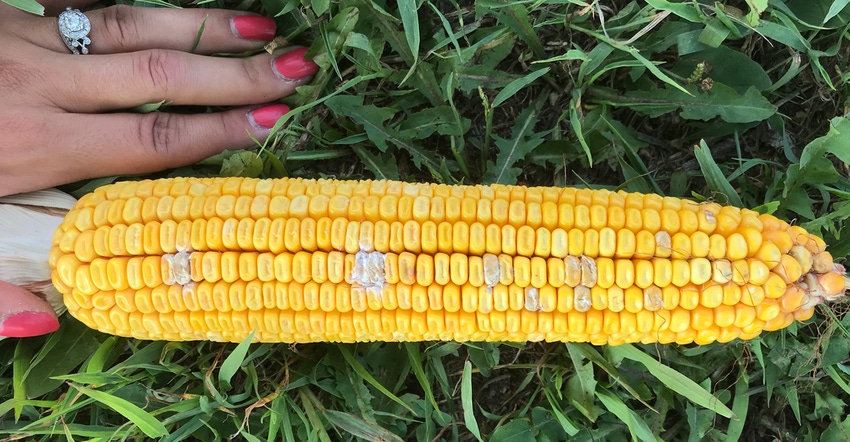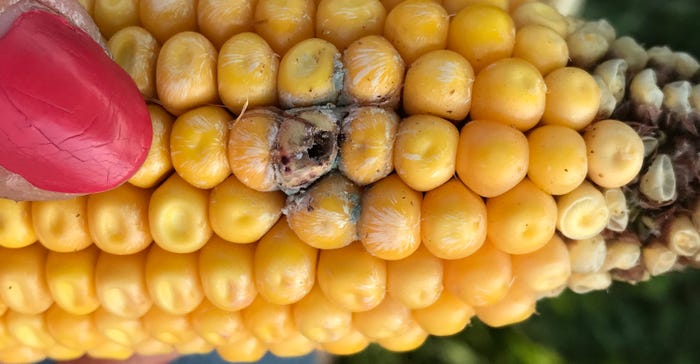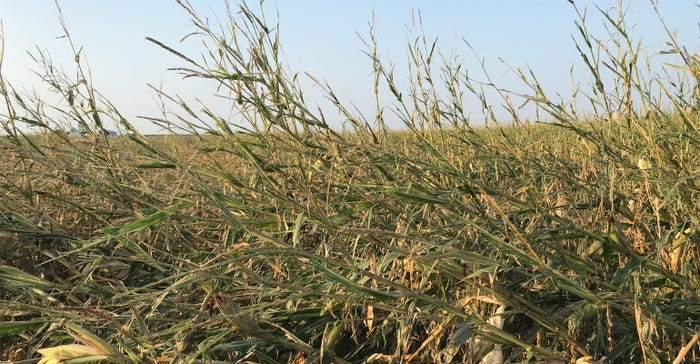September 9, 2020

The combination of drought, derecho and hot weather has Iowa crops maturing earlier than usual, creating various grain quality concerns. Corn ear rots and mycotoxins may be an issue in some fields, especially those hit by hail or that have insect injury to ears. Careful scouting before harvest is particularly important.
“Storm-damaged corn has been blown down and is laying on the ground and is quickly becoming moldy, which creates food safety hazards,” warns Charlie Hurburgh, professor and grain quality specialist in ag and biosystems engineering at Iowa State University. “The whole idea here is to get the producer and the crop insurance and the grain market together on determining value for the severely damaged grain. And how can we either take that as a total loss or direct it to another use, but not put it into the general commodity grain market.”
The drought-hit corn, on the other hand, is drying rapidly in the field. The key is to keep monitoring it for mold growth and toxin production during the drydown period and harvesting quickly if scouting shows those signs. “We are most concerned about the potentially aflatoxin-producing fungus Aspergillus flavus,” he adds.
 GREEN MOLD: In drought areas the biggest concern is molds developing, especially the aspergillus flavus fungus that produces aflatoxin.
GREEN MOLD: In drought areas the biggest concern is molds developing, especially the aspergillus flavus fungus that produces aflatoxin.

Toxins are generally produced as the grain is drying down from 30% to 18% moisture. Alison Robertson, ISU Extension plant pathologist, recommends that fields with more than 10% of the ears showing fungus should be harvested as quickly as possible even if the grain is of higher moisture content than would normally be harvested.
Hurburgh says there is a need for communication across the board, so that solutions can be reached without causing further problems down the line. It’s questionable how long some of this corn will keep during storage. Hurburgh and staff at the Iowa Grain Quality Initiative and ISU Extension offer the following advice for growers in drought and storm-damaged areas:
Crop insurance. Maintain contact with your crop insurance adjuster. Have a conversation about how grain quality will be handled in your individual policy. It's important to ask about the specific quality factors (test weight, damage) and feed safety factors (mycotoxins) that will be considered.
Marketing plans. Call your elevator to ask how or if different qualities of grain will be accepted. Ask them what factors they will look at and if there will be acceptance limits.
Mold growth. Continue to scout the grain on ears in the field for quality issues (primarily mold development). Continue reporting what you find to your crop adjuster, even if there has already been one visit for quantity loss determination. Mold development on corn ears could change acceptance, use and valuation. Again, ask the crop insurance agent about special markets for severely damaged corn and the process for zero valuing if quality continues to deteriorate before harvest.
Grain testing. Before feeding it yourself to livestock, have the corn grain tested. Key factors to consider are test weight, protein and mycotoxins. A veterinarian can access testing from Iowa State on these factors and help interpret data. Ration mixes may need to be adjusted for composition. Smaller animals may have issues with consuming grain with a low test weight (low density). All mycotoxins have guidance levels for the maximum content of each mycotoxin by the livestock species consuming the feed.
More information available
Videos are available on these topics:
Drought and Derecho.The Iowa Grain Quality Initiative staff discusses the drought and derecho, providing information on how these events are affecting the 2020 crop and the quality impact on corn and soybeans.
Mycotoxin Risk. Erin Bowers, a grain-quality specialist with ISU Extension, discusses the risk of mycotoxin contamination in Iowa grain and what to do about it. The drought and derecho are causing an increased risk for mycotoxin contamination this year.
Silo or Grain Bags. After the damage and destruction of many grain bins on farms and at grain elevators by the derecho windstorm in August, a large amount of storage space has been lost. On this video, the Iowa Grain Quality Initiative and Dirk Maier, an ISU professor of ag and biosystems engineering, details a potential temporary storage solution. Using big plastic grain bags, sometimes called silo bags, is a proven technology that could be deployed to deal with this temporary storage dilemma.
For specific information on grain quality, storage and testing, visit the Iowa Grain Quality site. Also, a live webinar on grain storage and corn quality will take place at 7 p.m. Sept. 17. The webinar is free but preregistration is required.
 PROCESSORS: Feed mills, ethanol plants, wet millers and dry millers will likely not accept mold-damaged or very light test weight corn.
PROCESSORS: Feed mills, ethanol plants, wet millers and dry millers will likely not accept mold-damaged or very light test weight corn.

Keep grain quality in check
Experts with the Iowa Grain Quality Initiative advise caution when harvesting, storing, mixing and marketing corn grain that’s suffered from windstorm damage and drought in 2020.
“Call your elevator now before harvest, and plan accordingly,” advises Charlie Hurburgh, Iowa State University grain quality specialist. “Will they accept different qualities of grain? What factors will they look at? Will there be acceptance limits?”
Hurburgh provides the following precautions and observations.
In drought areas, the biggest concern will be field molds developing, especially the mustard-green aspergillus flavus fungus that produces aflatoxin. This mold shows up primarily after corn reaches maturity, from about 30% grain moisture content down through 18%.
In downed corn areas, corn maturity was halted abruptly by the Aug. 10 derecho windstorm. This will cause low test weight, very soft kernels, likely low protein and very short storage life. You can expect mold growth on downed corn, with several toxin potentials. Corn below 45 pounds per bushel test weight should not go into general commerce without knowing its intended use and the impacts on that use.
 STUNTED MATURITY: In downed corn areas, corn maturity was halted abruptly by the Aug. 10 derecho windstorm.
STUNTED MATURITY: In downed corn areas, corn maturity was halted abruptly by the Aug. 10 derecho windstorm.

Quality issues from drought or storm-damaged corn can become worse in storage; quality changes in storage are not covered by crop insurance. Mycotoxin levels typically don’t increase during storage if the corn is dried quickly after harvest to below 15% moisture content, cooled immediately, and managed by normal practices for aeration, center core removal and grain temperature monitoring. Extended wet holding and slow drying are not recommended for either drought or wind-damaged corn.
About the Author(s)
You May Also Like






